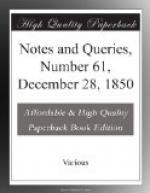“Welcome, John Sanderson,” &c.
Then, he taking up the cushion, they take hands, and dance round, singing as before: and this they do till the whole company is taken into the ring. Then the cushion is laid down before the first man, the woman singing, “This dance,” &c. (as before), only instead of “Come to,” they sing “Go fro,” and instead of “Welcome, John Sanderson,” &c., they sing, “Farewell, John Sanderson, farewell,” &c.: and so they go out, one by one, as they came in. This dance was at one time highly popular, both at court and in the cottage, in the latter of which, in some remote country villages, it is still danced. Selden, in his Table Talk, thus refers to it:
“The court of England is much altered. At a solemn dancing, first you have the grave measures, then the Corvantoes and the Galliards, and this is kept up with ceremony, at length to Trenchmore and the Cushion dance; and then all the company dance, lord and groom, lady and kitchen-maid, no distinction. (Would our fair Belgravians of 1850 condescend to dance with their kitchen-maids?) So in our court in Queen Elizabeth’s time, gravity and state were kept up. In King James’s time, things were pretty well. But in King Charles’s time there has been nothing but Trenchmore and the Cushion dance,” &c.
I shall also feel obliged for the date of Bab at the Bowster, or Bab in the Bowster, as it is called in Scotland. Jamieson, in his Dictionary, describes it as a very old Scottish dance, and generally the last danced at weddings and merry-makings. It is now danced with a handkerchief in place of a cushion; and no words are used. That a rhyme was formerly used, there is little doubt. Query, What were the words of this rhyme?
MAC.
Charminster.
* * * * *
DID BUNYAN KNOW HOBBES?
I observe a querist wishes to know the artist of the portrait of Bunyan prefixed to his works. I can only myself conjecture Cooper, the miniature painter, but I am also curious about the great author of The Pilgrim’s Progress.
First, is Bunyan really the author of “Heart’s Ease in Heart’s Trouble,” and the “Visions of Heaven and Hell,” published in his works, and perhaps, excepting “Grace Abounding,” the most popular of his received miscellanies? I think not. My reasons are these. The style is very different, and much poorer than his best works. In the “Progress,” when he quotes Latin, he modestly puts a side-note [The Latin that I borrow]. In the two tracts mentioned he flashes out a bit of Latin two or three times where he might have much better used English, or in a superfluous way. Also it is curious to know that in his “Visions of Hell” he meets Leviathan Hobbes, the philosopher of Malmesbury. The passage is curious, for if true, and written by Bunyan, it proves him to be personally acquainted with Hobbes. I extract it. After hearing his name called out, Epenetus (the author and visitant of the infernal regions) naturally inquires who it is that calls him. He is answered,—




